When working with numerical data in Excel, there are times when I need to convert decimal numbers into hexadecimal format. This is especially useful when dealing with computer programming, networking, or digital electronics. Fortunately, Excel makes this conversion process straightforward with its built-in functions. In this guide, I’ll walk you through different methods to convert decimal to hexadecimal in Excel.
Key Takeaways:
- The DEC2HEX function in Excel quickly converts decimal numbers to hexadecimal, saving time and reducing manual errors.
- The function’s syntax includes an optional argument to format results with leading zeros for consistency.
- DEC2HEX is useful in computing, electronics, and web development, particularly for memory addresses and color codes.
- Common errors like #VALUE! and #NUM! can be resolved by ensuring valid numeric inputs within the allowed range.
- Integrating DEC2HEX with other functions, such as IF and VLOOKUP, enhances data processing and automation in Excel.
Table of Contents
Introduction to the DEC2HEX Function
Easily Convert Decimal to Hexadecimal in Excel
In my experience working with Excel, I’ve found the DEC2HEX function to be incredibly useful. It quickly converts decimal numbers into their hexadecimal equivalents, making it a valuable tool for anyone dealing with computer science, digital electronics, or any field that relies on the hexadecimal system.
Think about it—manually converting a long list of decimal values to hexadecimal would be tedious and prone to mistakes. That’s where DEC2HEX comes in. With just a simple formula, I can get accurate conversions instantly, saving time and effort. It’s like having a built-in number translator that makes working with different numeral systems effortless.
Understanding the DEC2HEX Function
The DEC2HEX function in Excel follows a simple syntax:
- number – The decimal value I want to convert (required).
- [places] – The minimum number of characters in the result (optional).
If I don’t specify the [places] argument, Excel returns the shortest possible hexadecimal number. But if I do include it, Excel adds leading zeros to ensure the output has the specified number of characters. This can be especially useful when I need all results to have a uniform length for better formatting.
Step-by-Step Guide to Using DEC2HEX in Excel
STEP 1: Prepare My Data: Before I start converting decimal numbers to hexadecimal, I make sure my data is clean and organized. If my decimal values aren’t already in an Excel sheet, I enter them into individual cells. Once my data is structured correctly, I’m ready to move to the next step.
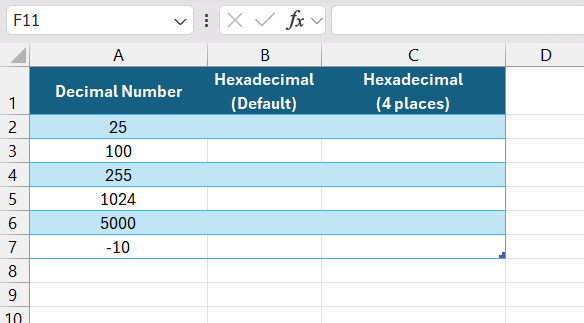
STEP 2: Select the Destination Cell: Now, I select the cell where I want the hexadecimal result to appear. This is where Excel will display the converted value once I enter the formula.
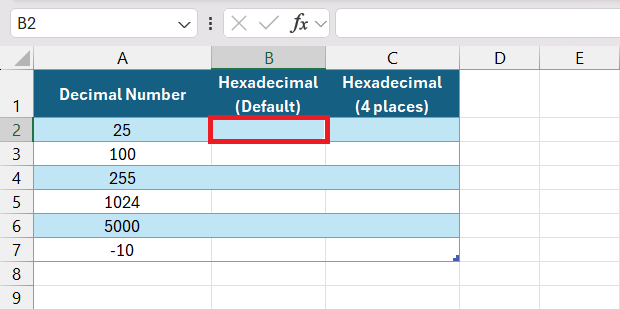
STEP 3: Enter the DEC2HEX Formula To convert a decimal number to hexadecimal, I type the following formula in the selected cell:
- number → The decimal value I want to convert
- [places] (optional) → The minimum number of characters in the output
For example, if my decimal number is in cell A2, I enter:
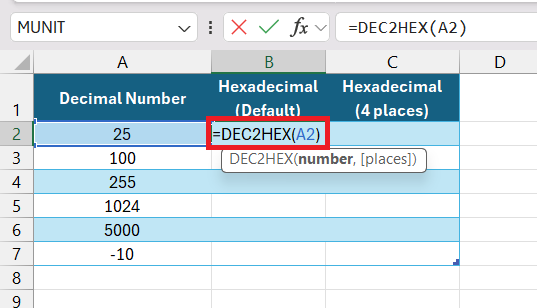
If I want the hexadecimal result to be at least 4 characters long, I use:
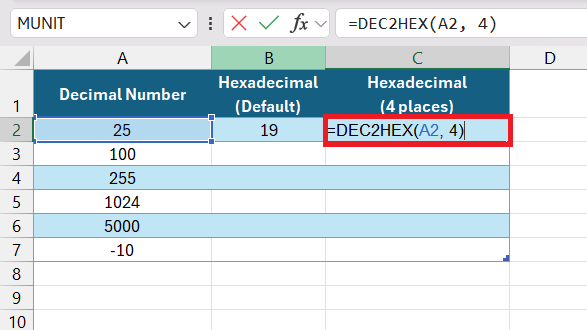
This ensures shorter results are padded with leading zeros (e.g., “0019” instead of “19”).
STEP 4: Press Enter to Get the Hexadecimal Value: After entering the formula, I press Enter to see the hexadecimal equivalent of my decimal number. Excel instantly calculates and displays the result.
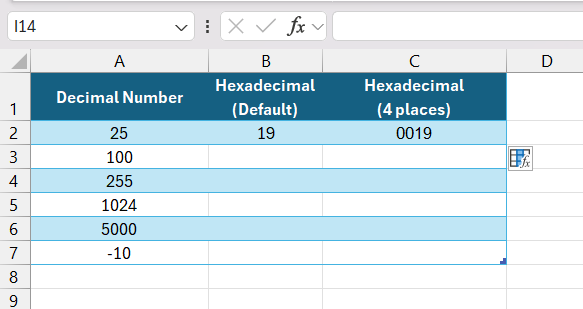
STEP 5: Apply the Formula to Multiple Cells If I have a list of decimal numbers, I don’t have to enter the formula manually for each one. Excel automatically converts each decimal number in the list, saving me time and effort. Just copy past the formula for all the relevant rows or drag the formula.
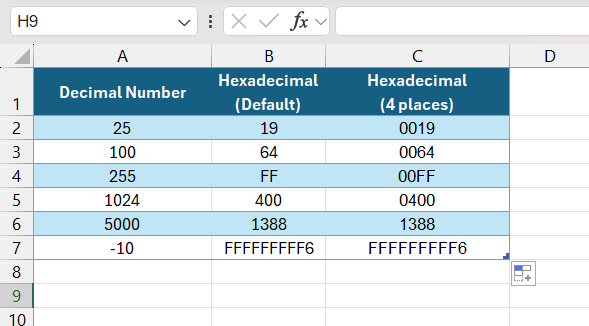
By following these steps, I can easily convert decimal numbers to hexadecimal in Excel using the DEC2HEX function. Whether I’m working with a small dataset or a large list, this method helps me get quick and accurate results without the hassle of manual conversions.
Practical Applications of DEC2HEX
Real-World Uses in Computing and Electronics
In the realm of computing and electronics, the practical applications of DEC2HEX extend far and wide. For instance, computer memory addresses are often expressed in hexadecimal format, making DEC2HEX an indispensable tool for programmers dealing with low-level memory management. Likewise, in web development, color codes are frequently defined using hexadecimal values. The pure red color, for example, takes the form of #FF0000 in hexadecimal, a representation derived from RGB values that DEC2HEX can easily convert for me.
For example, a database demonstrates how the DEC2HEX function can be applied in real-world scenarios across computing and electronics. The table showcases practical uses where decimal values are converted to hexadecimal, a numeral system commonly used in areas such as memory addressing, web development, and logic circuit design.
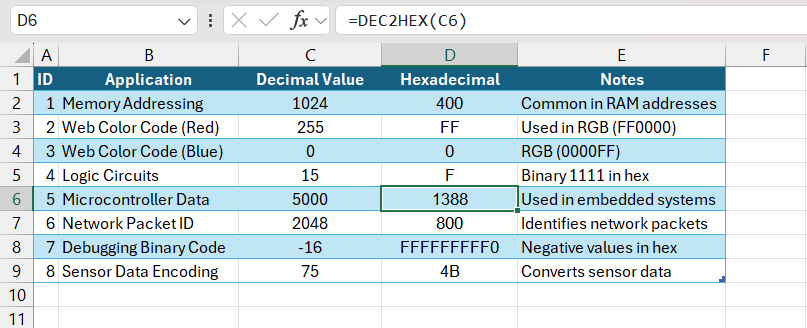
Beyond these, electronic engineers find DEC2HEX useful for simplifying binary-coded digital signals into hexadecimal format, which is easier to interpret and debug. The function serves as a bridge between the human-friendly hexadecimal system and the binary-coding inherent to machine language. As someone working with logic circuit design or debugging systems, mastering DEC2HEX enables me to translate complicated binary data into a more comprehensible form quickly. Such efficiency is particularly vital in time-sensitive environments.
Troubleshooting Common DEC2HEX Issues
Navigating Error Messages and Fixes
When working with DEC2HEX, I might sometimes face error messages. The most common one is #VALUE!, which typically signals that the decimal number I’m trying to convert isn’t recognized as a numeric value. To fix this, I ensure the cell referenced in the function contains a valid decimal number and not text or another data type.
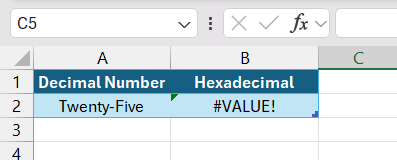
If inappropriate arguments are given or the range of the decimal number is outside of the acceptable bounds, Excel might display different error messages. For these cases, I double-check the arguments to ensure they’re within the specified range and formatted correctly. Paying attention to detail and understanding the nature of the errors goes a long way in troubleshooting issues with DEC2HEX.
Tips and Tricks for Advanced Users
Integrating DEC2HEX with Other Excel Functions
Integrating DEC2HEX with other Excel functions unlocks even more power for complex tasks. For instance, nestling DEC2HEX within an IF statement allows for conditional hexadecimal conversions only when certain criteria are met, keeping the data clean and precise without manual checks.
Example: =IF(A1 > 100, DEC2HEX(A1), "Value is too low")
In this scenario, the hexadecimal conversion occurs only if the value in cell A1 is greater than 100, offering a basic, yet effective form of data validation. I can also combine DEC2HEX with functions like VLOOKUP to match decimal values to corresponding hexadecimal codes in a table, automating cross-references between different numeral systems.
Additionally, incorporating DEC2HEX with CONCATENATE or the ‘&’ operator facilitates the creation of strings that blend static text with hexadecimal values, ideal for generating codes, tags, or other identifiers within a spreadsheet.
By creatively integrating DEC2HEX with Excel’s wide array of functions, I can craft solutions that are tailored exactly to my data processing needs.
Frequently Asked Questions
How to convert from decimal to hex in Excel?
To convert from decimal to hex in Excel, input the DEC2HEX function into a cell beside the decimal number: =DEC2HEX(A1), replacing A1 with the cell containing the decimal. Press Enter, and the cell will display the hexadecimal equivalent of the decimal number.
How do I resolve unexpected results with DEC2HEX?
If DEC2HEX in Excel gives unexpected results, double-check that the decimal number is within the valid range and that the formula references are correct. Ensure no text or non-numeric characters are present. Adjust the ‘places’ argument if needed to correct the output length.
Can DEC2HEX handle negative decimal values?
Yes, DEC2HEX can handle negative decimal values. In Excel, it converts negative numbers to their two’s complement hexadecimal equivalent, which is a standard representation for negative numbers in computing systems.
What should I do if DEC2HEX is not available in my version of Excel?
If DEC2HEX is not available in your version of Excel, try updating the software first. If it’s still unavailable, use a Visual Basic for Applications (VBA) macro to create a custom DEC2HEX function or find an add-in that provides similar functionality.
Is there a limit to the size of the decimal number that can be converted using DEC2HEX?
Yes, DEC2HEX has a limit on the size of decimal numbers it can convert. It handles numbers up to 549,755,813,887 and as low as -2,147,483,648. Numbers outside this range will yield a #NUM! error.
John Michaloudis is a former accountant and finance analyst at General Electric, a Microsoft MVP since 2020, an Amazon #1 bestselling author of 4 Microsoft Excel books and teacher of Microsoft Excel & Office over at his flagship MyExcelOnline Academy Online Course.







